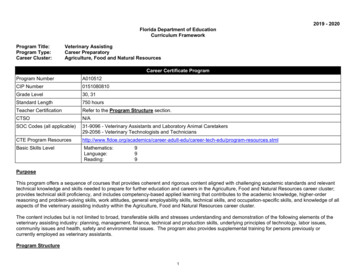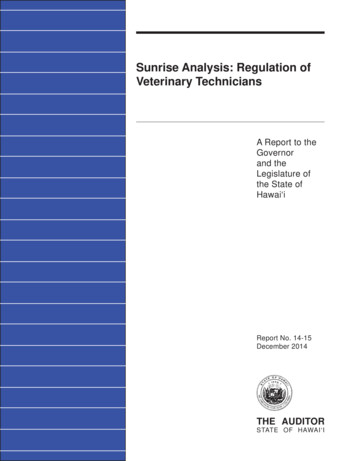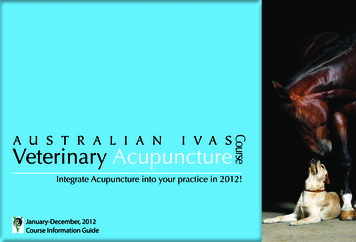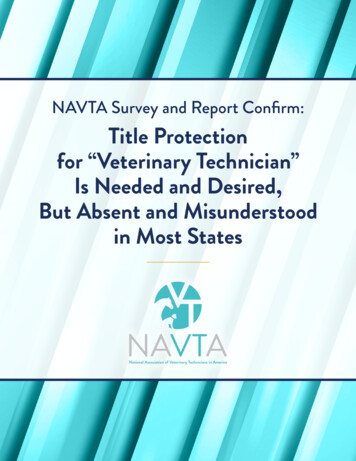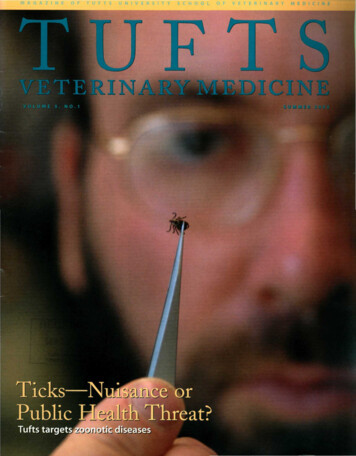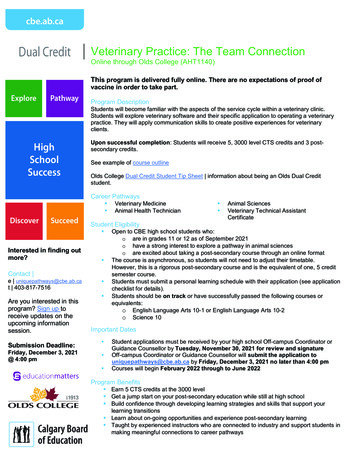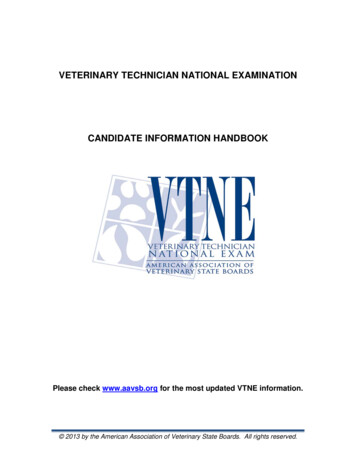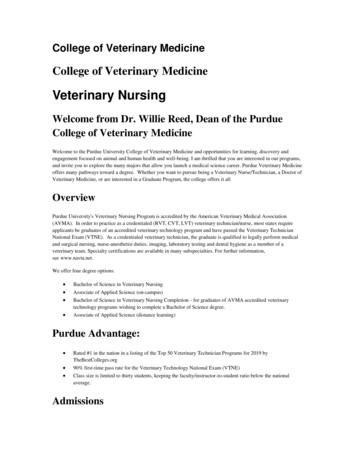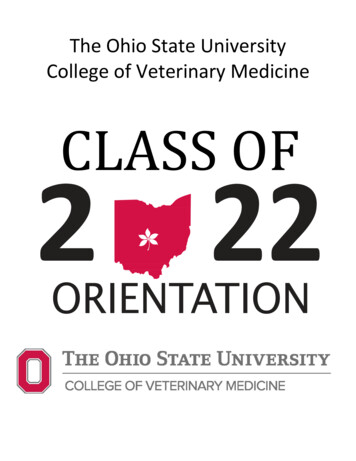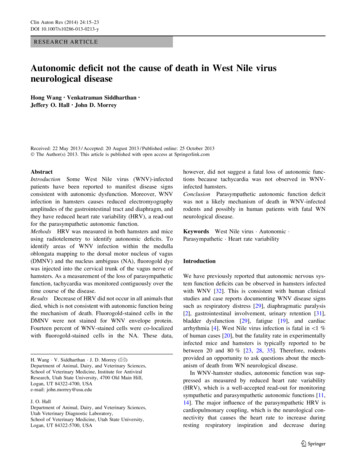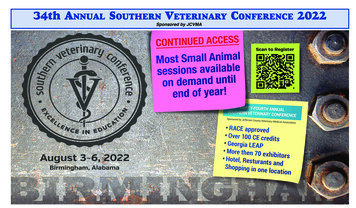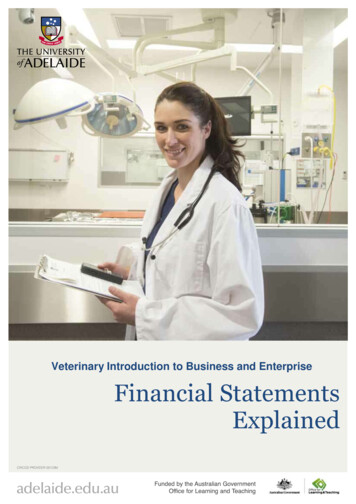
Transcription
Veterinary Introduction to Business and EnterpriseFinancial StatementsExplained
VIBE Learning GuideFinancial Statements ExplainedTable of ContentsIntroduction . 2Statement of financial position (balance sheet) . 3Assets . 4Liabilities . 5Owner’s equity. 6Income statement (profit and loss statement) . 7Profit . 7Revenue and expenses . 8References and acknowledgements . 8Authors . 8With the exception of the Commonwealth Coat of Arms, and where otherwise noted, all materialpresented in this document is provided under Creative Commons Attribution-ShareAlike 4.0 UnportedLicense roductionVeterinarians are not accountants, however there is a need for veterinarians to understandmanagement accounting. Management accounting is the provision of financial and nonfinancial information to business managers for the purpose of decision-making. The mostcommon forms of information for decision-making are financial statements. Underinternational accounting standards all businesses, including not-for-profit businesses, need tohave at least two general purpose financial statements. Depending on the country and the legalentity of the business several other financial statements may be required, however these arenot covered in this learning guide. The two financial statements that the veterinarian needs tobe familiar with are: statement of financial position (previously termed the balance sheet) income statement (previously termed the profit and loss statement)A brief summary of the components of each of these financial statements and examples fromthe case studies follows.The University of Adelaide2
Statement of financial position (balance sheet)The statement of financial position is a statement of assets, liabilities and owners’ equity as ata specific date. It is also called a balance sheet or statement of assets and liabilities. Thestatement of financial position for a business shows: what the business owns (assets)how it is financed (debt), andhow much equity the owners have in the business.The statement of financial position is based on the fundamental accounting equation:asset(s) liabilities owners’ equity.Consider your house (or your future house). It is an asset owned by you and financed partly bydebt (your mortgage) and partly by your equity. Assume that the house is worth 350,000 andyou have a mortgage of 180,000. Your balance sheet for the house would be:asset(s)( 350,000) liabilities ( 180,000) owners’ equity ( 170,000).The mix of debt and equity that we use to finance our assets is called leverage, or gearing.For an example of a statement of financial position (balance sheet) please see Table 1 below.Table 1. Summarised statement of financial position for Lamone and Yackaville Veterinary Practice 30th June2013Summary statement of financial position (balance sheet) Lamone and Yackaville Veterinary Practice 30th June 2013Cash and receivables 115,236Current assetsInventory 112,085Prepayments 6,908 234,229Fixed Assets 332,949Non-current assetsAccumulated depreciation- 50,000Intangible assets 35,000 317,949Total assets 552,178Accounts payable to trade creditors 95,057Current liabilitiesSuperannuation, PAYG, and Leave provisions 25,264GST NET payable 5,000 125,321Non-current liabilitiesLoans – equipment, trailer, motor vehicles 241,018 241,018Total liabilities 366,339Contributed capital 150,000Retained earnings after drawings and current 35,838year earningsTotal owner’ equity 185,839Total liabilities and owners’ equity 552,178As stated above, the statement financial position is based on the fundamental accountingequation:asset(s) liabilities owners’ equity.The University of Adelaide3
More information about the components of the financial statement follows.AssetsAssets are resources owned or controlled by a business that are expected to have current orfuture economic benefit. They are obtained or controlled by a business as a result of pasttransactions or events.The essential characteristics of an asset are: a probable future benefit exists involving capacity to contribute directly or indirectly to future netcash inflows; the business can obtain benefit and control access of others to the benefit; the transaction or event that gave rise to the business’s claim to, or control of, the benefit hasalready occurred.Assets are often split into two sub classifications: current assets non-current assets.Current assets are those assets to be converted into cash or used within the next accountingperiod, or 12 months. These assets include cash, inventory, accounts receivables (amountsowing from customers or debtors) and short term investments.Non-current assets are expected to remain in use for more than 12 months. These assetsinclude equipment, land, buildings and motor vehicles.Current and non-current assets can be monetary or non-monetary in nature. Monetary assetsare in cash terms or are claims to cash. These include cash at the bank or held by the business,accounts receivable and short or long term investments which are claims to cash. Nonmonetary assets are physical assets such as inventories, furniture, plant and equipment. Theseassets pose a valuation problem because the original dollar value is attributed to assets whenpreparing financial statements. Most physical assets wear out and/or decline in value overtime. A process of depreciation to allocate the decline in value of the asset over its usefulservice life in a systematic and rational manner is shown in a subsequent line as accumulateddepreciation. There are also intangible non-current assets such as copyrights, patents andgoodwill.To illustrate these definitions of assets, consider the following in Table 2 below:The University of Adelaide4
Table 2. Examples of assets and non-assets, and current or non-current assetsAsset or not?PeopleCar purchased outrightCar purchased with a loanCar purchased with a four year leaseLease of Plant & Equipment (initialpurchase, not wear and tear replacementof low value items)DrugsInformation‘Our greatest asset is our people’. Arepeople assets of a business? People canbe considered assets. However, abusiness cannot always obtain the benefitfrom people involved with the business.For example, consider the contracts ofprofessional sports people. A club may beable to stop a prized player from playingfor the opposition, but they cannot forcethe player to play for them at the best ofhis or her ability. Accordingly, people arenot included as business assets.Is leased equipment an asset?Interestingly, if we lease an asset as analternative to buying it, accountingstandards see the lease as a financingarrangement and an asset recognised as‘lease rights’. As such, business rightsover leased items are assets. Note, thereis also the liability of lease obligations.Is inventory an asset?Asset or not? Yes or NoNoYes, non-current assetYes, non-current assetYes, non-current assetsYes, current assetsLiabilitiesLiabilities are the economic obligations of an enterprise and represent the obligations of abusiness to transfer assets or provide services in the future as a result of past transactions orevents. Typically, liabilities are amounts owed to creditors, employees, government and others.A liability may also include an obligation to undertake a service. For example, an annualmagazine subscription paid in advance creates a liability to the publisher to post issues to thecustomer for the next 12 months. Similarly, a veterinary practice with annual wellnessprograms paid in advance would account for these as a liability to provide services to petowner customers for the next 12 months.The essential characteristics of liabilities are: the duty to honour the future transfer or use of assets at a specified or determinable date, onoccurrence of a specified event, or on demand;the business has little or no discretion to avoid the future sacrifice;the transaction, or other event, obligating the business has already happened.The University of Adelaide5
Owner’s equityOwner’s equity represents the interest of owners or shareholders in the assets of a business.For a company it is usually referred to as ‘share capital’, while for an unincorporated business itis referred to as ‘proprietorship’.Owner’s equity reflects the cumulative net result of past transactions, and other events orcircumstances, affecting the business. Accumulated profits or losses are recorded as part ofowner’s equity.The characteristics of equity are: It is a general interest in a business entity’s assets not a claim to specific assets. For example, ifI own half the shares in a company the shares are a general interest in all of the assets. I cannotdirectly identify my shares with particular assets or liabilities, thus I own a 50% share in allassets (and liabilities);Amount of equity is affected by the business entity’s operations and other events as well as bythe owner’s investments in the business and distributions to owners. Profits and new contributionby owners increase owner’s equity, while losses and dividends reduce it.Owner’s equity is the interest that bears the ultimate risks of business failure and reaps therewards of success. In the winding up of a company, the owners are the last to be paid, that is,after all of the creditors (those who have lent capital to the company) have been paid.Another way of representing the fundamental accounting equation is from the view of owner’sequity:Owners’ equity assets – liabilitiesAs in the example of a house owner:Owners’ equity ( 170,000) assets ( 350,000) – liabilities ( 180,000)As in the example of the veterinary practice (see Table 1):Owners’ equity ( 185,000) assets ( 552,177) – liabilities ( 366,339)The University of Adelaide6
Income statement (profit and loss statement)The income statement (profit and loss statement) is a statement of sales revenues, expenses,gains and losses showing the results of a business entity’s operations in a period. It is alsocalled the operating statement, the profit and loss account or the revenue statement. It is thestatement of financial performance or profitability.Profit or loss is measured as:profit revenue – expensesFor an example of a twelve month income statement (profit and loss) please see Table 3 below.Table 3: Example of a summarised income statement (profit and loss)Summarised Lamone and Yackaville Veterinary Practice Income Statement (Profit and Loss) 2012 - 2013Total SalesLess:Variable Costs(items)Less:Expenses(fixed costs oroverhead) 1,404,652Cost of Goods Sold 406,500SalariesTotal employee related expensesOther fixed operating costse.g. rent, electricity, repairs,insurance, telephoneInterestDepreciation 631,496 19,485Equals:Net Income(profit or loss) 406,500 235,810 14,204 33,179 934,174(totaloverhead) 63,978ProfitLet us now consider some basic rules that business managers (and accountants) use todetermine whether a profit or loss has been made. Remember, the income statement (profitand loss statement) reports the financial performance of a business over a period of time.Profit is defined, in an economic sense, as:the maximum value that can be withdrawn by the owners of a business entity, during aperiod, without reducing equity below the level determined for the beginning of thatperiod.Profit is measured as excess of revenue over expenses:profit revenue – expensesThe University of Adelaide7
Revenue and expensesDefinitions of revenue and sales for the purpose of management accounting for a simple salesrelated micro or small enterprise, such as a veterinary business, are: revenue total sales, and expenses are monies paid for costs incurred in day to day running of the business.Expenses can be further categorised into variable costs and general expenses (fixed costs oroverhead). For a typical veterinary business in Australia, all operational costs apart fromordered items/services can be considered fixed costs. Wages are sometimes seen as a variablecost for some businesses, but in the case of a typical Australian veterinary practice wages arenot able to be adjusted very much in response to demand. Furthermore, veterinary practicesfunction best with a core team of long term skilled staff.Revenue and expenses can only be reliably measured when sales invoices created for clients ofthe business and invoices received from suppliers to the business are accurately recorded.For more on invoicing of clients please read the Learning Guide ‘How to Charge’.For more on using financial statements to calculate veterinary fees please read the LearningGuide ‘Fee Setting for Veterinary Services’.For more on using financial statements to monitor financial performance please read theLearning Guide ‘Key Performance Indicators for Veterinary Business’.References and acknowledgementsCARLON, S., MLADENOVIC-MCALPINE, R., PALM, C., KIMMEL, P. D., KEISO, D. E. & WEYGANDT,J. J. 2012. Chapter 1 An introduction to accounting. Accounting Building Business Skills 4thEdition. Fourth ed. Australia Wiley.AuthorsDr Adele Feakes, Lecturer, School of Animal and Veterinary Sciences, Roseworthy campus, TheUniversity of AdelaideDr Dana Thomsen, Researcher, School of Animal and Veterinary Sciences, Roseworthy campus,The University of AdelaideThe University of Adelaide8
Table 1. Summarised statement of financial position for Lamone and Yackaville Veterinary Practice 30th June 2013 Summary statement of financial position (balance sheet) Lamone and Yackaville Veterinary Practice 30th June 2013 Current assets Cash and receivables 115,236 234,229 552,178 Inventory 112,085 Prepayments 6,908 Non-current assets
